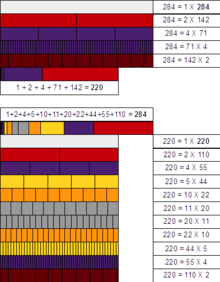
Back قضبان كويزنير Arabic Reglets numèrics Catalan Cuisenaire-Stäbchen German Regletas de Cuisenaire Spanish Cuisenaire zotzak Basque Réglettes Cuisenaire French בדידים HE Cuisenaire-rudak Hungarian Regoli Cuisenaire Italian 퀴즈네어 막대 Korean


Cuisenaire rods are mathematics learning aids for pupils that provide an interactive, hands-on[1] way to explore mathematics and learn mathematical concepts, such as the four basic arithmetical operations, working with fractions and finding divisors.[2][3] In the early 1950s, Caleb Gattegno popularised this set of coloured number rods created by Georges Cuisenaire (1891–1975), a Belgian primary school teacher, who called the rods réglettes.
According to Gattegno, "Georges Cuisenaire showed in the early 1950s that pupils who had been taught traditionally, and were rated 'weak', took huge strides when they shifted to using the material. They became 'very good' at traditional arithmetic when they were allowed to manipulate the rods."[4]
- ^ "Cuisenaire Rods Come To America". Etacuisenaire.com. Archived from the original on 2013-01-23. Retrieved 2013-10-24.
- ^ Gregg, Simon. "How I teach using Cuisenaire rods". mathagogy.com. Archived from the original on 13 September 2014. Retrieved 22 April 2014.
- ^ "Teaching fractions with Cuisenaire rods". Teachertech.rice.edu. Archived from the original on 2013-10-29. Retrieved 2013-10-24.
- ^ Gattegno, Caleb. The Science of Education Part 2B: the Awareness of Mathematization. ISBN 978-0878252084.